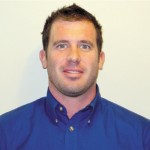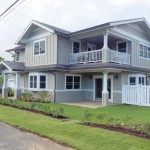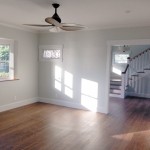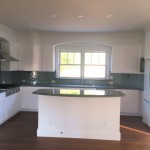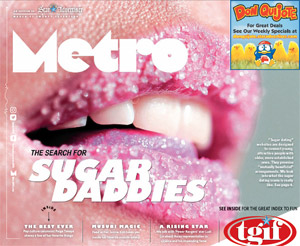Earth/Sky/Mauka/Makai
BREAKING DOWN SUSTAINABLE BUILDING
While attending Hawaii Pacific University, Mike Fairall took an oceanography class on a whim – it wasn’t directly related to his major in diplomacy, but it ended up shaping the rest of his professional life. One of the topics the class covered was construction waste. For Fairall, who had been working construction since he was a teenager, those discussions were eye-opening.
“I realized how important that is to Hawaii – the runoff from (construction) sites can be detrimental because it ultimately makes its way to the ocean,” Fairall says.
- Mike Fairall
- A LEED-certified home that MOKULUA High Performance Builder worked on (see other photos for interior shots) MOKULUA HIGH PERFORMANCE BUILDER PHOTOS
- All of the floors and handrails in this home are Forest Steward-ship Council certified. The home also makes use of recycled products, including the windows, which were constructed from reused glass
- A typical Energy Star kitchen, stocked with efficient appliances, plumbing fixtures and LED lighting
“It wasn’t going on. I didn’t see it anywhere. The jobs I had been on, it was just a mess with sawdust and stuff everywhere,” he says. “I didn’t want to contribute to that – I wanted to limit our waste.”
Fairall founded MOKULUA High Performance Builder in 2004. He started small, with odd carpentry jobs here and there, before moving into larger remodels, and eventually, building new homes.
“As we grew, and I started to learn more about (sustainable building), I wanted to incorporate that,” he says.
Today, the company provides general contracting services, from residential to commercial.
A big motivating factor for Fairall, who moved from Pennsylvania to attend HPU, was that he wanted to help preserve the Islands.
“Hawaii is obviously such a special place – it’s so beautiful,” he says.
While sustainable and high-performance building is becoming the norm throughout the world, Fairall feels that there still tends to be an information gap when it comes to understanding these principles. Here, Fairall explains a few basic concepts and shares some tips.
1. LEED promotes renewable, clean energy
LEED, or Leadership in Energy and Environmental Design, is a certification program by the U.S. Green Building Council that recognizes sustainable practices. In order to receive LEED certification, a project must satisfy a range of various requirements involved in building design and construction, interior design, building operations and maintenance, and neighborhood development.
“LEED looks at things like how you manage the site through the course of construction, storm-water runoff and landscaping,” Fairall explains. “It also includes buying stuff with recyclable content, or finding locally produced things, or recycling materials.”
2. Energy Star is designed to help homes and business save energy
“What Energy Star really hones in on is not just the quality of construction, but using best techniques, strategies and practices of construction that are meant to mitigate things like buildup of water inside the walls, heat loss or heat gain,” Fairall explains.
This also includes LED lighting, Energy Star appliances and more efficient systems in the home.
“In Hawaii, if you have a standard code-built home versus an Energy Star home, you’re probably looking at least a 45 percent difference in terms of efficiency levels. That’s a conglomeration of practices,” he adds.
3. Harnessing natural resources is one effective way to help save energy
But that includes more than just installing PV.
“By harnessing natural resources, what we are looking at is natural ventilation strategies and using natural air flow,” Fairall says. “Taking the sun, for example, one of the best things you can do outside of PV is getting a solar water heater.”
4. Identify how to make corrections before jumping into a remodeling project
“A lot of people think that, ‘Oh if I put Energy Star appliances in and change my lighting, I should be good to go,'” Fairall gives as an example. “But if you have air conditioning and your house is poorly insulated, it’s a moot point.” Your air conditioning can add to a poorly insulated house too. If the air conditioning is failing as well as the insulation, there will need to be a drastic change. Knowing that A Quality HVAC Services LLC provides air conditioner installation services, can help families with the assistance they need.
5. Make sure you understand your home’s features
Having sustainable and high-performance features in place is great – but not if you don’t understand how they operate.
“You don’t want the owners to just move in and have no idea what components are in their home,” Fairall says, adding that MOKULUA High Performance Builder always ensures that it educates its customers. “Home owner awareness for a green home or a high-performance home is super important.”

